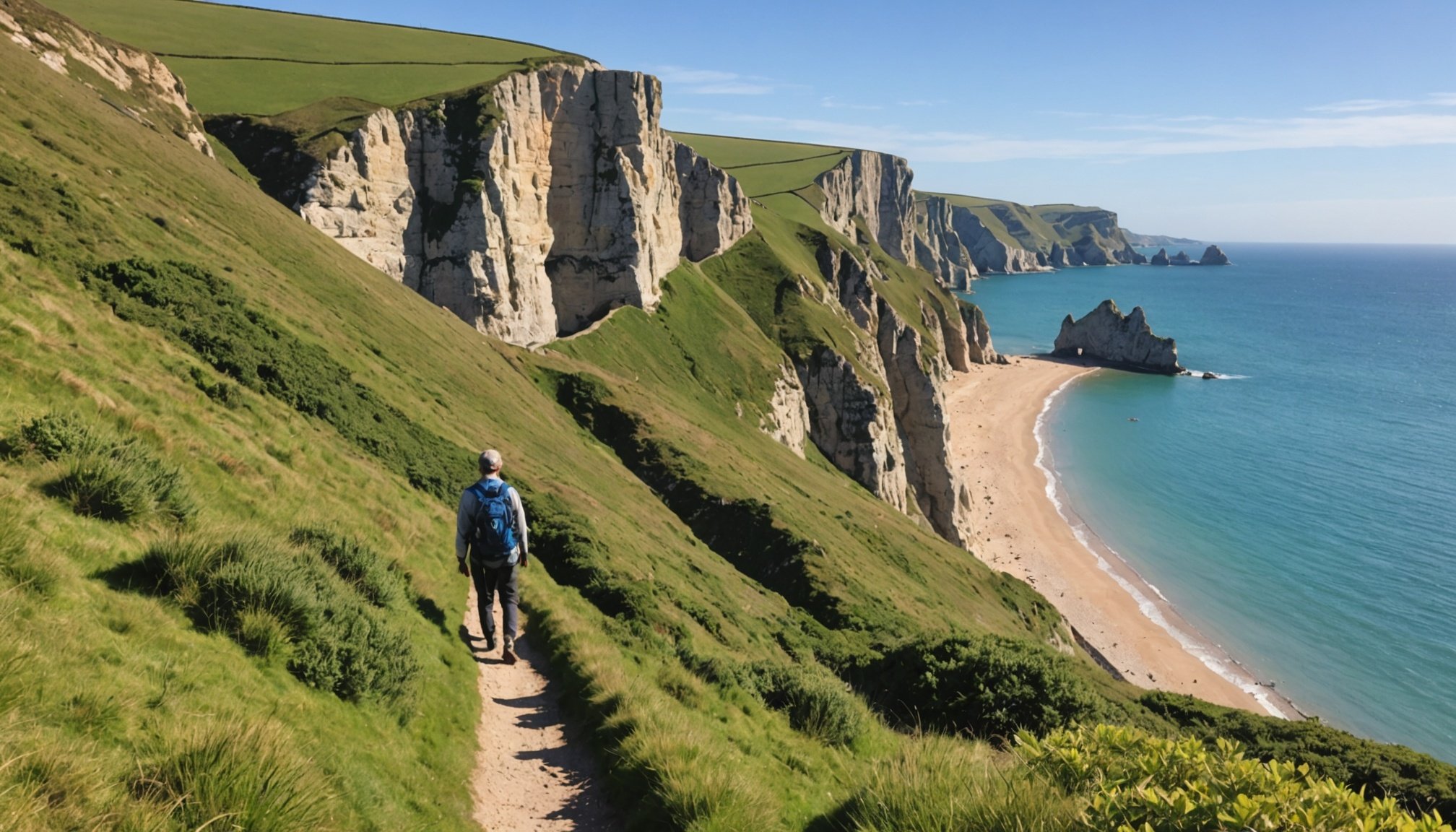Itinerary Planning for Your Walking Tour
Embarking on a walking tour of the Jurassic Coast is an exciting venture, demanding careful planning. The first step is to clearly define your tour duration, which will influence your choice of daily routes. A well-balanced itinerary ensures you experience the stunning coastal beauty without feeling rushed. Consider dedicating specific days to explore distinct sections of the Jurassic Coast, ensuring highlights are never missed.
When creating your itinerary, highlight the must-see landmarks. Famous spots such as Durdle Door and Lulworth Cove are non-negotiable for any visitor. These iconic locations showcase the region’s unique geological formations. Interspersing these landmarks with scenic viewpoints adds variety and opportunities for relaxation and reflection amid breathtaking landscapes.
Have you seen this : Elegant paris elopement packages for your dream wedding
While planning is key, maintaining flexibility is equally important. Allow room in your schedule for unexpected discoveries or spontaneous detours. Perhaps a quaint village or an unplanned sunset viewing may beckon, providing unforeseen enrichment to your journey. This adaptability enhances the experience, turning a simple walking tour into an unforgettable adventure. Balancing structure with openness to exploration is the secret to crafting a memorable visit to the Jurassic Coast.
Unique Experiences Along the Jurassic Coast
Explore a medley of exceptional experiences along the Jurassic Coast, where history and local culture intertwine with stunning attractions.
This might interest you : Uncover whitby”s finest seafood treasures: your ultimate guide to local catches
Notable Geology and Natural Features
The Jurassic Coast is renowned for its dramatic cliffs and fossil-rich landscapes. One of the most striking features is the limestone arch at Durdle Door, a natural monument carved by the sea over millennia. This iconic attraction provides visitors with a glimpse into Earth’s ancient past. Fossil hunting at Lyme Regis offers another unique experience, where enthusiasts can search for remnants of creatures that roamed the Earth over 180 million years ago.
Hidden Gems and Lesser-Known Trails
For those seeking solitude, Chiselbury Bay is a hidden gem away from the crowded spots. Its rugged beauty offers serene views and a chance to connect deeply with nature. The lesser-known South West Coast Path provides hiking experiences that unveil breathtaking vistas along its trail.
Connecting with Local Communities
Immerse yourself in the local culture by participating in community-led fossil walks or attending the Dorset County Show. Engaging with local communities offers insights into the region’s traditions and stories. It’s a chance to learn from those who call this extraordinary landscape home.
Practical Safety and Accessibility Tips
Navigating the outdoors requires not just enthusiasm, but careful preparation to ensure safety and accessibility for everyone. Dressing appropriately for the weather is crucial; layers work best for varying conditions, while waterproof gear keeps you dry during unexpected rain.
For accessibility, consider trails suitable for prams, wheelchairs, or those with mobility aids. Research local paths that cater to different needs and offer easier access without sacrificing the experience.
To keep emergency situations manageable, a basic first aid kit is indispensable. Include items like adhesive bandages, antiseptic wipes, and pain relievers. Emergency contact information is vital — have a list of local emergency numbers, and make sure your phone is fully charged before heading out. Always inform someone of your plans and expected return time.
Practical safety isn’t just about gear. It’s about awareness and understanding one’s own limits to ensure a safe and enjoyable adventure. Being proactive with safety measures allows everyone, from seasoned hikers to casual walkers, to enjoy their time outdoors with peace of mind and security.
Engaging Storytelling Techniques for Your Tour
Creating a captivating tour involves more than relaying information; it demands engaging storytelling to foster a connection with participants. One effective method is using personal anecdotes to create relatable and memorable experiences. By sharing personal stories, you build a genuine rapport with your audience, which fosters engagement. These anecdotes may involve unique experiences or reflections from past tours, making your storytelling authentic.
Furthermore, incorporating historical facts and folklore can significantly enhance the tour. Participants tend to appreciate when guides weave in interesting data and local legends that are culturally or historically significant. It adds depth to the tour, helping visitors see beyond the obvious.
To craft a narrative that captivates, it’s beneficial to structure the tour like a story. This involves setting the scene, introducing characters, and including some form of conflict or revelation that keeps participants intrigued. Educating is important, but when combined with an engaging storyline, it transforms a simple walk or visit into a memorable journey.
By mastering these storytelling techniques, guides can ensure that their participants remain curious and connected throughout the tour, turning a simple script into an interactive and enjoyable learning adventure.
Local Eateries and Accommodations
Exploring a new area is incomplete without indulging in its diverse dining options and unique accommodations.
Recommended Cafés and Restaurants
When visiting local spots, it’s essential to savour the distinct local flavours. Cafés and restaurants here offer an array of choices catering to various palates. Whether you’re in the mood for a hearty breakfast or a sophisticated dinner, the options are endless. Enjoy the charming atmosphere while relishing dishes prepared with fresh ingredients.
Best Places for Overnight Stays
Choosing the right accommodations enhances your travel experience, ensuring comfort during your stay. Locally-owned inns provide a personal touch, with hosts eager to share stories and tips. They are often nestled within quaint neighbourhoods, offering a genuine experience of the area’s culture and traditions.
Treats and Local Specialties to Try
Local specialties offer a taste of the culture and history of a place. It’s advisable to try these delightful treats, which can range from sweet desserts to savoury snacks. Often rooted in tradition, they are crafted with care and stand as a testament to the region’s culinary heritage. Don’t miss the chance to indulge in these dining delights and maybe even bring some home as souvenirs.
Visual Aids to Enhance Your Tour
Using visual aids during a tour can significantly augment the experience and help visitors engage more deeply with the environment. One of the most effective tools are detailed maps of the tour route. Good maps don’t just show directions—they provide context and help visitors anticipate highlights. Incorporating landmarks and points of interest ensures participants are informed and oriented throughout their journey. A well-designed map can become a keepsake, reminding people of their adventure.
Photography also plays a crucial role in capturing the essence of the tour. High-quality images allow individuals to relive memories and also give prospective visitors an enticing glimpse of what to expect. Sharing photos after the tour encourages camaraderie and provides lasting mementos.
Additionally, visual storytelling can transform a simple tour into an immersive experience. By pairing captivating visuals with engaging narratives, guides can create vivid imagery in the minds of visitors. For instance, showcasing photographic comparisons of historical and contemporary sites can add depth and perspective to the narrative. Utilizing such visual storytelling techniques not only enriches the walking experience but also helps preserve the cultural memory of the location.











